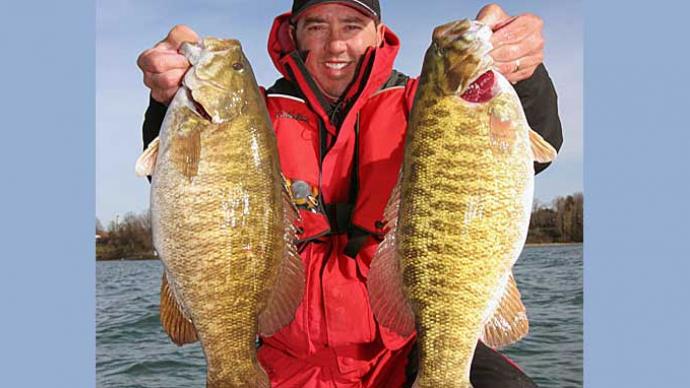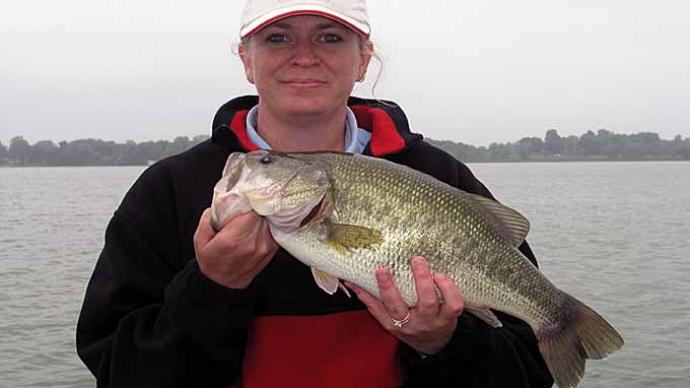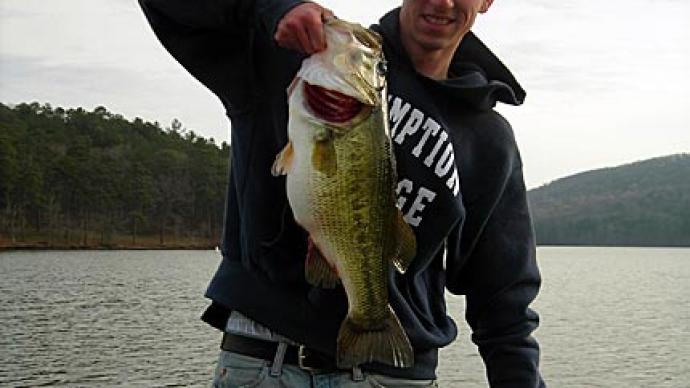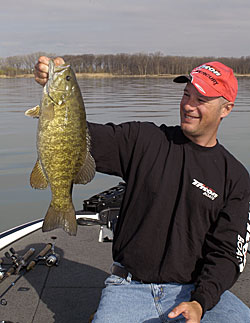
Smallmouths that have spent an entire winter in a state of semi-torpor in deep water begin a steady migration to the shallows as soon as the ice goes off, if not before. Initially, the migration is twofold: to find more comfortable digs and to find food. The bass won't leave the shallows for several months from right after ice-out until the spawn has concluded. Smallies are lethargic when the water is super cold. Often, it takes an agonizingly slow, deliberate presentation to convince them to eat. A hair jig can tantalize the coldest smallie into partaking, and the tempting undulations of natural hair are more than a bass can stand.
"There's nothing like a hair jig for triggering smallmouth when they first get into the shallows," said smallmouth guru Joe Balog. "There's a short window right after ice-out, maybe three days to two weeks, when hair jigs absolutely kill 'em. Once the water temperature tops 42 degrees, you can catch 'em on something else, but until then, hair jigs rock!"
Balog said for years, he tied his own hair jigs. "They don't have to be too fancy, but in cold water, there's something about how natural hair moves that drives smallmouths crazy. I think it's something the human eye might not even be able to see. It's so imperceptible. Just a minute quivering, pulse or maybe bubbles trapped in the hair that trips a smallmouth's trigger."
Some of the best hair jigs are those made by Cervidae Hair Jigs. Many serious guys make their own using pill, round ball, or even football jig heads. We tied them with sparse gray and white bucktail to imitate emerald shiners on Lake Erie, but other colors work better depending on location. Hair jigs excel from when bass are still clustered in 40 feet of water mid-winter haunts until they move into the shallows just after ice-out.
Don't spare the rod when fishing hair jigs. Balog recommends a St. Croix Bass X 7-foot, 1-inch medium/heavy casting model, a reel loaded with Suffix 832 braid, and an 8-pound fluorocarbon leader.
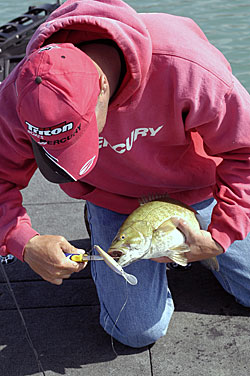
The waters eventually begin to warm, and the bass perk up. When bass are still lethargic, a jerk bait is the only thing that can produce the prolonged pause with the lure balancing in the strike zone. The prolonged pause is often needed to tantalize fish when they first wake up.
"The timing for using suspended jerkbaits is very predictable," Balog said. "The first time you have a few consecutive days of stable, warming, sunny weather, you can count on the jerk bait bite kicking it."
Bass guide Gerry Gostenik convinced me to target smallmouth at the mouth of the Detroit River when everyone else was thinking walleye. Even though it was still April, Gostenik reasoned that it was time for smallmouths to be packing into a back bay where baitfish would also be accumulating. Strengthening spring sunshine raised the surface temperatures in the bay into the 50s, which signaled that it was time. It was barely above 40 degrees in the river.
There was a narrow trench leading into the bay that went from 4 to 5 feet that the smallies used like a highway. The idea was to make long casts and work the suspending jerk bait back to the boat with short rips and long pauses. The longer the pause, the better it seemed. Initially, many of the bass were hitting short, and we weren't hooking up, but the bass became more aggressive as the water temperatures increased. By late afternoon, we'd caught at least 50 bass, and many would scare the heck out of 6 pounds. Several of the bass were spitting up minnows of different sizes when we brought them to the boat. The spring bite was definitely on, and the hundreds of anglers on the Detroit River adjacent to us had no idea of the fun we were having.
"When fishing suspending jerk baits in the spring, you can use casting or spinning gear. The key is to crank quickly to get the bait down, and then use a sweeping motion and a pause to trigger strikes," offered Balog. "I like baits like the Rapala X-Rap and Lucky Craft Pointer 100. Anglers claim that you need to fish the lure by giving it extremely long, extended pauses, but if I have to do that to trigger strikes, I'll put on something else that I can fish faster and still catch fish." He said that braid with a 12-pound Suffix fluorocarbon leader is perfect for fishing jerk baits when combined with a longer, medium-action rod.
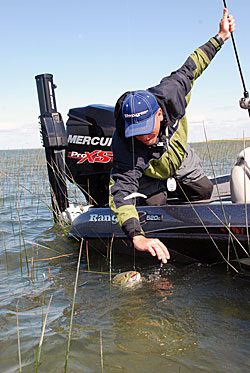
Swimbaits are another lure that excels in the early season. "I've always been a big fan of Keitech soft plastics," Balog said. "Their swimbaits fish well, especially in cold water in early spring. I like to rig them on a VMC boxer head jig. They're strong and have an excellent hook. The idea with swimbaits in cold water is to make long casts and reel steadily, allowing the bait to bang the rocks like you're just slowly rolling it. You can make good hook sets with a single solid hook, and your hook-up percentages are good. Balog prefers St. Croix's 7-foot, 4-inch Bass X casting rod (BXC74MHMF) when fishing swimbaits.
Blade baits are an overlooked tool for fishing cold water. "The main thing about blade baits is you have to have faith in a hunk of metal," Balog joked. "They lack plastic's action, scent, or feel, but they work. You have to believe."
Blade baits have been around since the first Silver Buddy; there are many similar baits on the market, including Reef Runner's Cicada, Heddon's Sonar, and the Vib-E-Blade. "I usually use a 1/2-ounce blade bait. When fishing it, you need to retrieve and lift it at the same time. You want to be able to barely feel the lure vibrate, not the kind of vibration that you feel up your arm. Kind of swim it with small, short 10- to 12-inch lifts, allowing it to drop to the bottom." He constantly changes the treble hooks on blade baits from the number 4 factory hooks to number 6 VMC hooks that are sticky sharp and adds different split rings.
Balog said blade baits are best fished on a softer, medium-action rod, like St. Croix's 7-foot Legend Elite (ES70MF). The softer action provides the feel you need to fish blades properly.
Once early season bass show signs of putting on the feedbag, it is an excellent time to bring out the tubes. "Tubes are tried and true," Balog commented. "One key to fishing tubes in the shallows is the hook eye angle. Normally I'd use a jig with a 60-degree eye if I were fishing in the grass, but in the shallows, you want to have a jig with a 90-degree eye. It helps you when draggin' the bait and keeping contact with the bottom, which is important in the early season."
He typically favors a 4-inch tube for most fishing and is partial to the ISG Intimidator tube. It has a multitude of tails or tentacles that move tantalizingly in the water. Another good source for quality tubes and jigs is Provider Tackle.
Many anglers are itching for the ice to disappear to get on the water. Go armed with these lures, and you can catch smallmouths from ice-out through post-spawn.
BassResource may receive a portion of revenues if you make a purchase using a link above.


